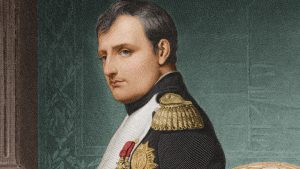Welcome back to our survey of the historical utter nonsense people believe. Today we address five more myths that, despite the widespread availability of Google, still cling stubbornly to the human canon. Let’s jump right in…
 Image: Ramasside
Image: Ramasside
6. Slaves built the Egyptian Pyramids
Hollywood has given us this warped version of the construction of the iconic monuments. From The 10 Commandments to Prince of Egypt, the story has been that hordes of slaves were forced to provide the labor that raised one of the most enduring symbols of ancient accomplishment. While that may align with modern American moviegoers’ association of the Exodus story with Egypt’s most famous structures, it’s pure fantasy.
Archaeology done at the site has made it very clear that the project wasn’t accomplished with slave labor. Rather, a rotating system of labor owed to the Egyptian government by its citizens was employed (think of it as taxes in the form of work). By all available evidence, these builders were treated well for the duration of their work period. In fact, the Egyptian organizational system behind the construction is perhaps even more impressive than the buildings themselves.
The origin of the myth lies in the assumption that the Biblical Exodus story occurred around the time of the building of the pyramids (to say nothing of the assumption that this otherwise unsupported scriptural tale, complete with a parted sea, is true at all). This, combined with an equally unsupported claim of Egyptian’s use of slave-labor by ancient historian Herodotus, fostered the idea that the Biblical figures must have built the elaborate tombs.
When Israeli Prime Minister Menachem Begin visited Egypt’s National Museum in Cairo in 1977 and claimed that “We [as in Israelites] built the pyramids,” the story gained even more mileage. The Egyptian press was outraged, showing how a poor understanding of history can lead to serious offense.
 Image: Wikimedia
Image: Wikimedia
7. Pilgrims came to America for religious freedom
The romantic notion of oppressed religious dissenters fleeing European theocracy and finding freedom in America is a bedrock of the national mythos. And while it is true that religious minorities were persecuted in Old England, and that the concept of separating church and state was formalized in colonial New England, the Puritans who settled the land did not believe in religious tolerance—far from it.
There’s some serious confusion over the terms “Pilgrim” and “Puritan,” which differentiate between the first group that came over on the Mayflower and later settlers. In truth, they were all Puritans, though with some theological differences, and they were all small-p pilgrims in that they undertook a journey for religious reasons. What matters, though, is that they didn’t need to come all the way across the Atlantic to find religious freedom. They had already found it in Europe, and they hated it.
Puritans wishing to escape derision in England first settled in Holland, where they were perfectly free to worship (or not) however they pleased. Unfortunately in their view, so was everyone else. Fearful that other cultural and religious influences in the tolerant and diverse haven of Holland would infect their children and taint the “purity” to which their moniker referred, they decided to go elsewhere. America, they figured, was not just a place where they could practice freely—it was a place where they could isolate themselves from any notions other than Puritan ones. It was a place where they could maintain strict control over the beliefs of everyone in their communities.
Eventually, the dogmatic extremism of Puritan society collapsed under the weight of its own self-righteousness. Today, the term “Puritanical” is synonymous with closed-minded, prudish, and judgmental. Rightly so; the witch-hunters of New England didn’t believe in anything like religious freedom.
 Image: Bio
Image: Bio
8. Marie Antoinette said “Let them eat cake.”
The phrase “Qu’ils mangent de la brioche” became a symbol of the ugliness of aristocracy, after it was attributed to the unlucky French Queen Marie Antoinette. She allegedly blurted the response after being informed of serious bread shortages that left the French peasantry starving while the more fortunate revelled. It was seen to show just how disconnected the ruling class, soon to be overthrown, was. It made Antoinette look like the sheltered, ignorant, callous bitch that some revolutionaries claimed she was. It was either so disgusting in its lack of empathy, or so appalling in its ignorance of the struggles of the common man, that it made her eventual beheading seem a matter of poetic justice.
The ignorance, however, is on the part of those who actually believed she said it. The quote came from the unreliable autobiography of French Enlightenment philosopher Jean-Jacques Rousseau. Rosseau attributed the quote to an anonymous “great princess” who couldn’t possibly have been Antoinette given the year it was written, when she was just a prepubescent girl living in Austria.
In fact, Antoinette’s own letters reveal a sharper awareness of the plight of her people than revolutionary stereotypes would suggest. She mentions her concern over the food shortages and a wish to see the ruling class “work hard for [the peasants’] happiness.” Alas, compassionate sentiments don’t fill bellies, and the rage of a misruled people eventually cost the relatively innocent queen her head.
 Image: Bio
Image: Bio
9. Napoleon was short.
Speaking of the French Revolution, its supporters’ well-intentioned efforts to bring about a more democratic way of life descended into utter chaos, and from the chaos rose one of the most powerful autocrats in history: Napoleon Buonaparte. But as powerful as he was, generations of people have believed that he was really, really short. His historic conquests, they say, were exaggerated efforts to compensate for his embarrassing lack of stature.
Napoleon, however, had nothing to worry about, at least by 19th-century standards. He was around 5’7” —pint-sized for a modern man, but above the average height of his contemporaries. Despite this, “Napoleon complex” has become…ahem…shorthand for when an undersized fellow picks a lot of fights.
The myth has complex origins. British propaganda depicted Napoleon as short in order to demean him. Napoleon’s nickname among the French, le Petit Caporal (the Little Corporal, sometimes translated as the Little General), lent credibility to the myth, but “petit” in this context was meant affectionately, not literally. On top of that, members of Napoleon’s personal guard were required to be at least 6 feet tall, huge by 19th century standards, making Napoleon appear diminutive by comparison. Finally, some international confusion over French units of measurement, which were larger than the British Imperial inches, led to a mistaken notion of his official height.
Call him what you want (dictator, egomaniac, all-around jerk), but short he was not.
 Image: Daily Beast
Image: Daily Beast
10. Abraham Lincoln owned slaves.
This one falls squarely into the “How on Earth does anyone believe this?” category, but believe it they do. It’s a consistently Googled question, and a false point raised repeatedly everywhere from talk radio to Klan meetings. No, Abraham Lincoln did not at any point in his life own slaves, but as Lincoln historian Gerald J. Procopowicz (author of Did Lincoln Own Slaves? And Other Frequently Asked Questions about Abraham Lincoln) puts it, “…people keep asking.”
Where did this notion come from? The short answer is Southern revisionism. As the Civil War receded into the past and the losing side found themselves in the embarrassing position of having torn the nation apart to defend its ugliest practice, the need to rewrite the story arose. Thus arose the “Lost Cause” approach, in which Southerners fought primarily for states’ rights, not slavery, against “Northern aggression.” In this version, the Southern whites are the oppressed minority struggling to earn freedom, not the slaves.
Of course, the facts make slavery extremely hard to set aside. From the open declarations by Southern leaders of white supremacy as a basis for secession, to the simple fact that Lincoln’s election is what triggered the secession, it takes a Herculean exercise in self-delusion to…ahem…whitewash the story this way.
While revisionists twist legitimate facts (there were Union slave states, most Southerners didn’t own slaves, etc.) as an everyday tactic, sometimes they just plain make shit up, too. By claiming Lincoln was a slave owner, today’s apologists for treason in defense of slavery can obfuscate the origins of the conflict.


